On Monday and Tuesday this week we are going to have the AFR national Energy Summit in Sydney with everyone there, including Josh, Jay, Bill, Andrew Vesey and a different Malcolm Roberts (Chief Executive, APPEA). Should be fun.
The Weekend AFR had about half a dozen articles, led off by an article by Ben Potter, Angela Macdonald-Smith and Mark Ludlow (no doubt pay-walled) which said our energy has become dirty, expensive and annoyingly unreliable. They reckon something has to be done, it’s just that:
the causes identified by Prime Minister Malcolm Turnbull – or unofficial backbench energy spokesman Tony Abbott – are not the same as the causes power industry experts and regulators highlight.
Here’s the graphs about prices:
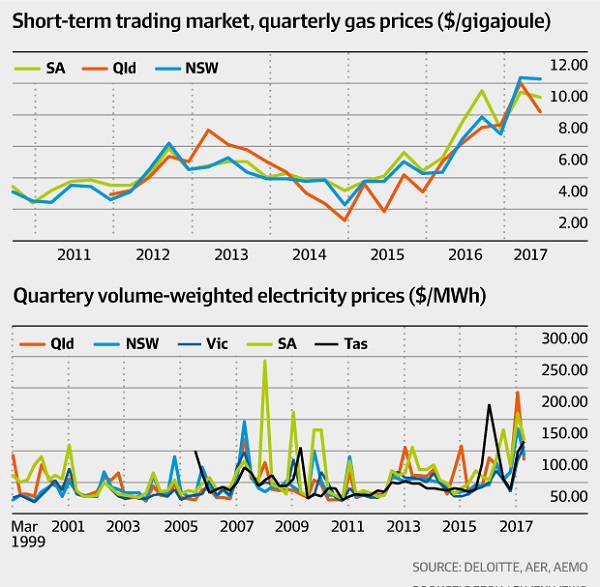
And here’s how we are going with emissions:
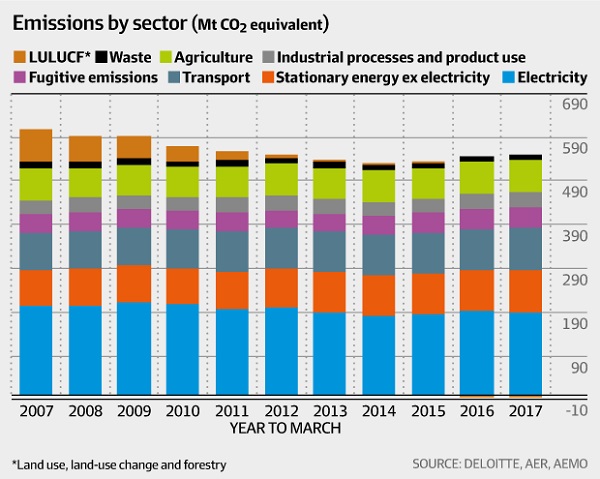
In today’s AFR Potter is there again, saying:
- The energy industry, the agencies that oversee the energy markets, and most of the customers are united around a common view.
But not Turnbull with his cabinet and fractious back bench.
Basically, pass the CET and get on with investment in new energy, then leave the management to the women appointed to manage it all.
In this CC I’ve selected some current items about renewable energy, mainly solar, plus a few to remind us that we live in a changing climate. Here I’ll briefly note a new report by the Climate Council Powering a 21st Century Economy: Secure, Clean, Affordable Electricity. It covers much familiar ground, but a couple of pieces of information are worth noting.
First, on page 17 it has a table that shows 453MW of coal and gas power failed in SA on 8 February, on 10 February it was 3050MW in NSW and on 12 February 787MW in Queensland.
Second, on page 18 it gives the cost of new build power, showing renewables cheaper than gas and much cheaper coal even without CCS, which, let’s not fool ourselves, is the only way coal could be clean.
1. Sydney, Melbourne urged to prepare for 50C days by end of century
- Sydney and Melbourne have been warned to prepare for scorcher days reaching 50 degrees Celsius by the end of the century — even if global warming is contained to the Paris Agreement target of a 2C increase.
There is one thing wrong with this story. Lawrence Torcello and Michael Mann reckon the way we are going we’ll reach 2°C of warming by about 2036. Here’s what the CO2 graph at Mauna Loa looks like:
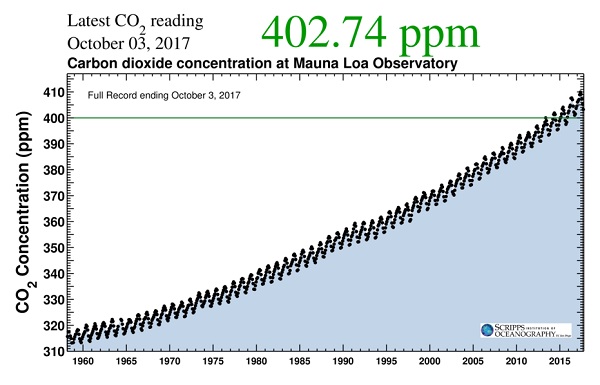
Actually a more expert report of the research from Liz Hanna of the ANU shows that the researchers were thinking of those temperatures by 2040 or earlier.
Electricity grids transmit less power as the ambient temperature rises, generators are apt to fail. Emergency services are impeded – in a heat wave in Melbourne in 2014, 203 deaths were reported to the coroner, more than twice the average.
Dr Mark Monaghan says A lack of action on climate change is putting people’s lives at risk.
2. Record temperatures in September
All sorts of temperature records were broken in Australia in September, including the hottest day on 22 September, with an average maximum of 33.47°C. The hottest month remains 2013, but this was probably the most significant comment for the climate:
- Research conducted in 2014 by Sophie Lewis from the Australian National University found if greenhouse gases in the atmosphere were at pre-industrial levels, Australia would break that September record just once every 704 years. But current levels of greenhouse gases make that 16 times more likely.
Lewis said that estimate was now considered conservative, with actual extreme weather being seen as almost impossible without the influence of greenhouse gases.
Here’s the map for 22 September:
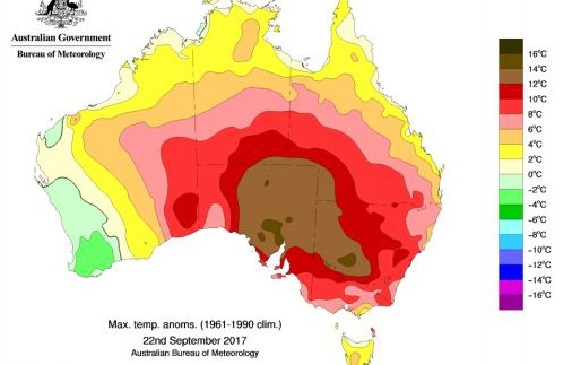
At Think Progress we learn that the climate denying scientists at the University of Alabama have declared last month as the hottest September ever recorded in the four decades of satellite data they’ve assembled:
- Equally amazing, “of the 20 warmest monthly global average temperatures in the satellite record, only September 2017 was not during an El Niño,” reports Dr. John Christy, director of UAH’s Earth System Science Center — and an infamous climate science misinformer.
3. Solar power is fastest-growing source of new energy
- Solar power was the fastest-growing source of new energy worldwide last year, outstripping the growth in all other forms of power generation for the first time and leading experts to hail a “new era”.
Renewable energy accounted for two-thirds of new power added to the world’s grids in 2016, the International Energy Agency said, but the group found solar was the technology that shone brightest.
New solar capacity even overtook the net growth in coal, previously the biggest new source of power generation. The shift was driven by falling prices and government policies, particularly in China, which accounted for almost half the solar panels installed.
The Paris-based IEA predicted that solar would dominate future growth, with global capacity in five years’ time expected to be greater than the current combined total power capacity of India and Japan.
4. Stunning new low for solar PV as even IEA hails “age of solar”
RenewEconomy (link above) led with the news of a new record low price for solar:
- The cost of solar PV has hit a stunning new low – with a bid for a 300MW solar project in Saudi Arabia pitched at just $US1.79c/kWh – or $US17.9/MWh ($A22.7/MWh) – with no subsidies.
The stunning offer – coming in the oil kingdom’s first major tender for solar power – represents a significant fall of 75 per cent in costs below those considered “not credible” less than two years ago.
This is where the renewables have been built in the past few years:
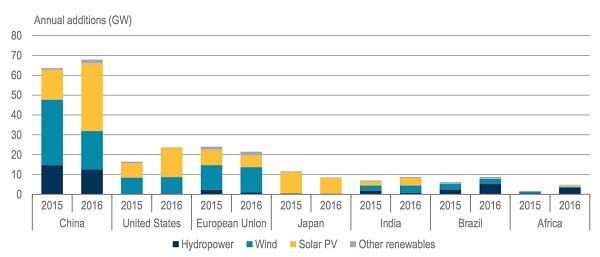
5. US future energy mix
The US Energy Information Administration has done an Annual Energy Outlook, 2017, with projections to 2050. I think it was produced in January, so pre-Trump. It has many graphs, but this one of total energy consumption gives the overall idea:
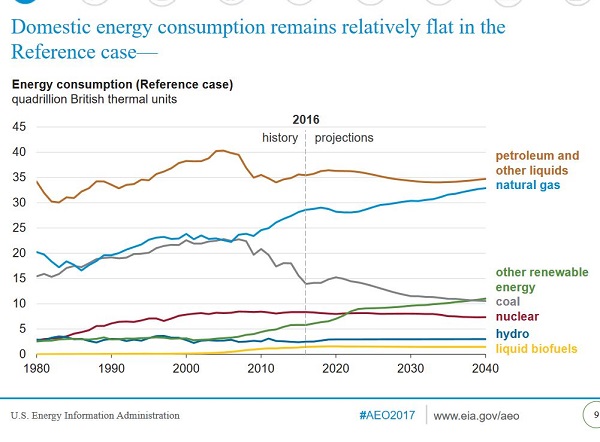
Coal is down, the big winner is gas, and renewables other than hydro and biofuels are up, but not spectacularly so. We can only hope they are wrong. They emphasise uncertainty, so they are almost bound to be wrong.
6. What did the IEA forecast, and are they right?
Carbon Brief has two posts:
- IEA: Renewable electricity set to grow 40% globally by 2022
- Analysis: How have the IEA’s renewable forecasts changed?
The first headlines the world’s renewable electricity capacity rising sharply over the next five years, expanding 43% on today’s levels. But expansion levels off.
Here’s the graph showing their forecasts since 2013 against what is happening:
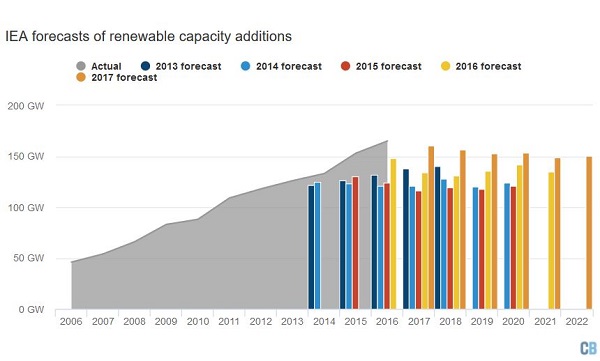
This tweet shows even more starkly what’s been happening with their solar PV forecasts since 2002:
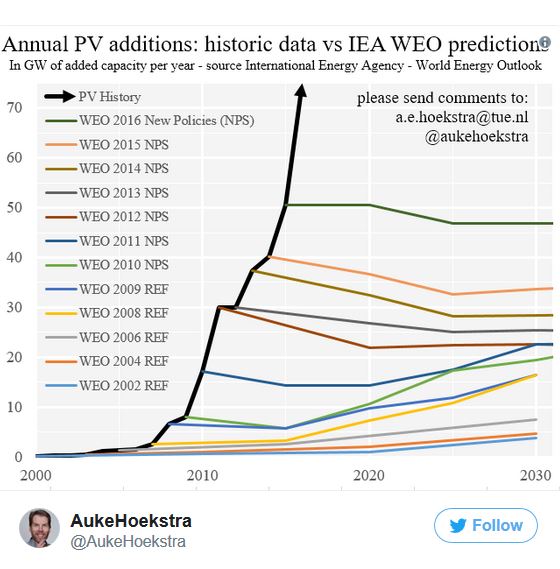
Tim Buckley, director of energy finance studies at the Institute for Energy Economics and Financial Analysis (IEEFA), puts his finger on the problem:
- “IEEFA would put the deflation in total installed system costs for solar as likely to continue at 5-10% annually, double the 4% pa rate the IEA forecasts. Therein lies the core problem. They will be upgrading their renewable energy forecasts again next year.”
Eventually one would think they’d learn.
This is what happened last year:
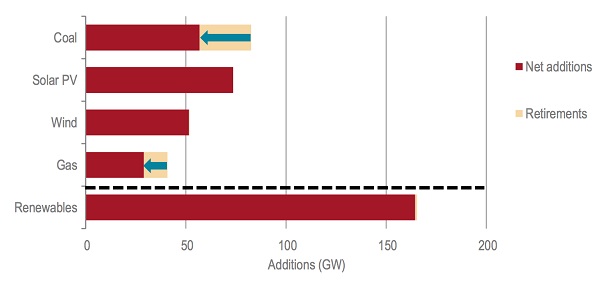
I think, however, we should keep our eye on the Mauna Loa graph.
7. Gas flowing south
Back on 27 July the AFR ran an article Tables turned on east coast gas supplies. For over 18 months Queensland has acted like a giant Hoover, but now there are signs of a sea change in the flow of gas.
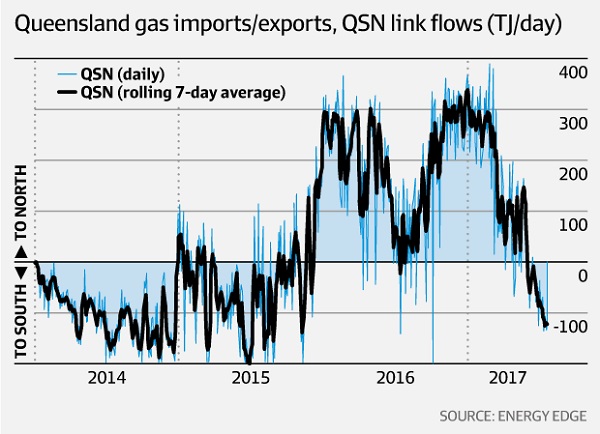
It’s about increased supply and a warmer winter in the south, rather than the PM’s jaw-boning as such. What happens to price in longer term contracts is another matter.
8. Amazing pictures of Larsen C
Larsen C iceberg is very large – about a trillion tons, in area about equal to the state of Delaware, or four Londons, with a volume of about 462 million Olympic size swimming pools. In depth it’s about the Statue of Liberty times two.
This article has some great pictures, including this screenshot:
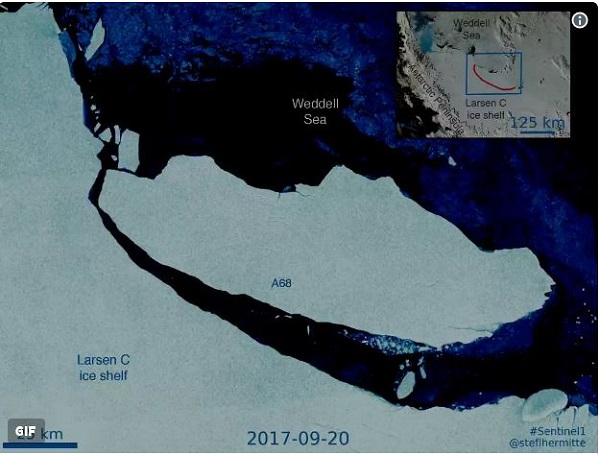


To all,
I had the opportunity to attend an event on 2 August 2016, hosted by Engineers Australia (EA) and the University of Technology Sydney (UTS), titled The Big Conversation: Our climate and energy dilemma – Is there a case for emergency action? The eminent speaker was Ian Dunlop, highlighting the serious risks that climate change poses for our social, financial, and energy systems, and the opportunities that are available to urgently re-frame our economy. A video of this event can be viewed at: https://youtube.com/watch?v=CNT1XjBAxRE
Contents of this video with time intervals shown include:
0:00:00 Introduction by event moderator Adjunct Professor David A. Hood AM
0:05:30 Address by Professor Greg Skilbeck – Deputy Vice Chancellor, UTS
0:14:15 Address by John McIntosh – Chair, Board of EA
0:18:47 Adj. Prof. David Hood outlines EA’s leadership role
0:29:15 Animation presentation: Tracking CO2 in Our Atmosphere
0:34:30 Adj. Prof. David Hood introduces eminent speaker, Ian Dunlop
0:35:24 Event eminent speaker: Ian Dunlop’s presentation
1:35:00 Adj. Prof. David Hood introduces the discussion panel
1:37:47 Discussion panel perspectives
1:53:00 Audience questions (4) and discussion panel’s responses
2:06:58 Session ‘wrap up’: Greg Ewing – Sydney General Manager, EA
2:09:46 End
Beginning at time interval 1:15:21, Ian Dunlop says:
Clearly, emergency action is required. When will our leaders take effective action?
There’s going to be more about what Ian Dunlop says in my next post.
AfR are live-blogging the Summit, and obviously had some of the papers beforehand.
It looks as though the Feds will walk away from the CET, say affordability and reliability are the key. Submissions reduction will look after itself with technology change. They are still obsessing about Liddell, however. There is talk of taxpayer funds to help.
It’s clear from vesey that if they want Liddell they’ll have to confiscate it. AGL are going to do what they are going to do whether there is a CET or not, although that would be nice.
Seems there is double what we’ll lose from Liddell in the pipeline, but the Feds are not impressed. They still think Liddell coal power is “dispatchable”.
Frydenberg is saying they will have to change the NEM operating rules. He doesn’t seem to realise that there is an Australian Energy Market Commission and an Energy Security Board operating under COAG, where they have one vote.
Jay Weatherill says the Feds have shown they can’t lead and should just get out of the way, and leave states to run the NEM.
Audrey Zibelman says we just need to get on with it all. The market isn’t so much about to change, it has changed, and AEMO is getting on with making it work. It’s a happening thing.
Had a chat with my wife. I said Mal and Josh were just being ignorant. She was not so charitable, reckons they know exactly what they are doing.
She’s probably right. Jennifer Hewett in the AFR says Josh wants to be PM some day. The sad fact is that since Mal topped Tony, whoever leads the Liberal Party has to be acceptable to Barnaby Joyce.
The AFR editorial says the power problem is basically politics.
Jay Weatherill put it very plainly on RN Drive. If you have an externality you want to get rid of, you put a price on it.
He’s very serious about it and reckons the Liberal states of NSW and Tas are open to moving on it.
Remember the Finkel Review was commissioned by COAG, not the Commonwealth. And the NEM was initiated by COAG, not the Commonwealth, with the initial law being passed in the SA parliament.
Giles Parkinson sees the Coalition wrestling with its inner demons.
David Leitch says Frydenberg has just made an election-losing speech.
From the AFR – NSW and SA back Alan Finkel on carbon policy:
That’s indeed a radical idea, Mr Weatherill.
Many electors are sceptical of the existence of State governments; if the States got this particular act together, they would be stars!
Better get Nick Xenophon persuaded of its wisdom, in the SA case.
Brian,
Re: “5. US future energy mix”
Posted at resilience.org on 16 Jan 2017, is the article Will the US Really Be a Major Energy Exporter? looking at the US EIA’s Annual Energy Outlook 2017 projections. I think it would be unwise to accept EIA AEO projections uncritically. The AEO projections shown above are clearly incompatible with the requirements of the Paris Climate Agreement.
Are we heading towards a post- ‘peak oil’ world?
There’s a re-post at resilience.org on 6 Dec 2016, of the article World Energy Outlook 2016 – Fatih Birol in Brussels, where Kjell Aleklett reported on the International Energy Agency (IEA) presenting its annual World Energy Outlook 2016 (WEO-2016) report in Brussels. Scroll down this article until WEO-2016 Figure 3.16 is revealed, preferably while sitting down. Kjell Aleklett says:
In The Sydney Morning Herald on 28 Feb 2017, Brian Robins’ article headlined Low oil prices set to recede, BHP warns, amid sluggish output gains, reports comments from Michael Hovers, BHP Billiton group’s marketing petroleum vice-president, who said:
Is IEA’s WEO-2016 Figure 3.16 wrong? Are Michael Hovers’ comments wrong? What’s the evidence? What are the implications for our civilisation if they are close to reality? Is our society prepared for it?
Australia’s low in-country liquid fuel stock holdings
In crudeoilpeak.info on 23 June 2017, Matt’s post headlined Australia’s oil stock coverage on record low highlights Australia’s in-country real consumption cover, for period 2010 – April 2017, for:
Crude oil feedstocks: were between 20 and 30 days;
Automotive petrol stocks: were between 15 and 27 days;
Diesel stocks: were between 10 and 20 days; and
Jet fuel stocks: were between 15 and 25 days.
On 28 January 2015, at a public hearing for the NSW Parliament Select Committee inquiry on the Supply and Cost of Gas and Liquid Fuels in NSW, I heard – I was there as an observer, and the Committee Hansard reported that then NSW Minister for Resources and Energy, Anthony Roberts said, concerning liquid fuel security:
Australia is the only one of the 28 IEA Member countries that continues to fail to meet its 90-day fuel stockholding obligations. Please see Engineers Australia’s (#02) submission at this Senate inquiry.
What to do? Become informed and ask our leaders/representatives inconvenient questions!
Liquid fuel security is critical for our transport systems, as currently configured. Petroleum is embodied in just about everything we touch. But ask our political elite what planning is being done for an inevitable post- ‘peak oil’ world, or for an unreliable/disrupted supply, and see what the response is.
As an exercise ask your local council whether they have a post- ‘peak oil’ policy – most don’t – and those that don’t are likely to say that’s a State/Territory and/or Federal issue. Then ask your State or Territory Member of Parliament – they’ll likely say that’s a Federal issue. Then see what your Federal Member says. I have for all 3 tiers of government for where I reside, and my perception is this issue is all too difficult for our leaders/representatives to deal with. My assessment is our civilisation is woefully ill-prepared for declining and/or unreliable/disrupted petroleum fuel supplies. More people need to be asking our leaders/reps inconvenient questions, and perhaps then effective change may come.
Thanks Brian yet again.
Geoff Miell, to your last point, Peal Oil solutions are largely the same as Climate Change Action solutions. Electrification, reduced consumption, population growth minimisation, liquid biofuel development and production, and, IMHO, nuclear powered shipping.
While we have a raging climate change denialist running the government agenda from the back benches I can’t see how there can be any serious preparation in this country.
BilB,
‘Peak Oil’ solutions are largely the same as Climate Change Action solutions – I agree.
Even if people are rabid climate change deniers, or “skeptics”, surely they cannot deny we live on a finite planet? We cannot keep extracting finite oil & gas reserves at current rates (let alone increase them) and maintain current costs. Energy Return on Investment (EROI) continues to decline with fossil fuel extraction, because we go for the “low hanging fruit first” and are left with increasingly more difficult/costly to extract resources.
Evidence I see indicates our world is fast approaching ‘peak oil’ supply & ‘peak gas’ supply. If we wait to confirm that these events are actually happening, it will already be too late, because it will take time to make the necessary changes to transition. We need to be making the transition while fossil fuels are still relatively affordable – keep the demand curve below the supply curve.
I think there are clear, affordable, reliable, effective solutions for electricity generation, but we need to get cracking and start the transition in earnest. The really tough assignment for humanity is finding and implementing affordable and timely solutions to substantially diminish our dependency on petroleum – that’s where I see the greatest challenge is, and we are fast running out of time – and our leaders seemingly continue to ignore this one.
So, if you are having a conversation with a climate change denier or “skeptic”, re-frame the argument in terms of finite resources, resource depletion and rising resource extraction costs – see where it goes.
BilB,
my responses/musings to your comments earlier are as follows:
Electrification – wherever possible/affordable – electrified fast & high speed rail – rail needs to become the dominate mode of long-distance (>200 km) land transport – discourage further gas network expansion and decommission residential gas supply network no later than 2035 (see my letter headlined Gas decline, published in ATA’s ReNew Issue 141 – Oct-Dec 2017 magazine, on page 12).
Reduced consumption/increased recycling/increased efficiency – humanity is a profligate squanderer of energy and resources – we need to do very much better – we will likely be forced to do so soon.
Zero population growth – Perpetual growth in a finite world is impossible – If you look at Ian Dunlop’s presentation referred in my first comment above, beginning at time interval 0:40:15, he shows humanity on a global scale is already consuming about 1.5 times Earth’s biophysical resources – clearly unsustainable, but no mainstream politician seeking re-election will touch this subject, yet – but I live in hope to be pleasantly surprised soon.
Liquid biofuels – currently have very poor Energy Return on Investment (EROI) and unless this attribute improves significantly it will remain within a small niche market – see this discussion paper for more details. Aviation is most at risk because there are no affordable large-scale petroleum direct-replacement liquid biofuel alternatives, so far, and reconfiguring for hydrogen (or electric?) energy propulsion is hugely problematic and challenging. Evidence I see suggests the Western Sydney Airport that the Federal Government is proceeding with is likely to become a white elephant even before it becomes operational in the mid-2020s.
Nuclear-powered shipping – Uranium and thorium are finite energy resources – Evidence I see would suggest there aren’t enough global supplies of high-grade uranium ores available to meet and sustain demand for current stationary energy (power station) needs beyond about the end of this century. Adding extra demand from more stationary generators and/or introducing mobile reactors for global shipping needs would put an even greater strain on existing supplies and deplete these reserves sooner. There are low-grade uranium sources but that means higher costs. There are substantially more reserves of thorium, but the thorium fuel cycle has still not been established and it’s a multi-stage process. As I understand it, a proportion of non-fissile (but fertile) Thorium-232 transfigures to fissile Uranium-233 in a nuclear reactor (similar in principle to fertile Uranium-238 transfiguring to fissile Plutonium-239), followed by a hazardous reprocessing operation to refine/concentrate the active ingredient before becoming available as a reactor fuel. And with nuclear-powered ships being mobile adds greater complexities and risks of unintended losses – incompetency, propulsion/steering failure, storm damage, fire, collision/grounding, sinking, high-jacking, etc. I’m not advocating this option be excluded/ignored, but I’m saying that the pesky problem of nuclear fuel resource depletion, and that nuclear engineering requires a much higher standard of skills/competency in design, construction, operation, decommissioning and disposal to minimise the risk of dire incidents occurring, cannot and must not be ignored. But I’m puzzled why the Australian Government is focussed on diesel-powered submarines to replace the current Collins-class, particularly when the apparent favoured design is a major untried modification of a French nuclear-powered design.
As I expressed in my earlier comment: – I think substantially diminishing our petroleum fuel dependency is our greatest challenge, and there are no easy solutions. Perhaps that’s why our leaders are ignoring it – too hard – but that doesn’t help us all in the long-term!
Check out this video: EXTRACTED – How the Quest for Mineral Wealth Is Plundering the Planet. It’s almost 9 minutes of run-time. It’s a book promotion by the author Ugo Bardi, but there are some key points being made within and I think it’s worth a look, and yes, I’ve read this showcased book:
https://www.youtube.com/watch?v=u_Y29DqzWkc
In the view of Sharanjit Paddam, principal at Deloitte Actuaries and Consultants and convener of the Actuaries Institute’s climate change working group.
You have been warned.
Ootz, thanks for that one.
Four degrees is usually taken to be the point at which civilisation as we know it falls apart.